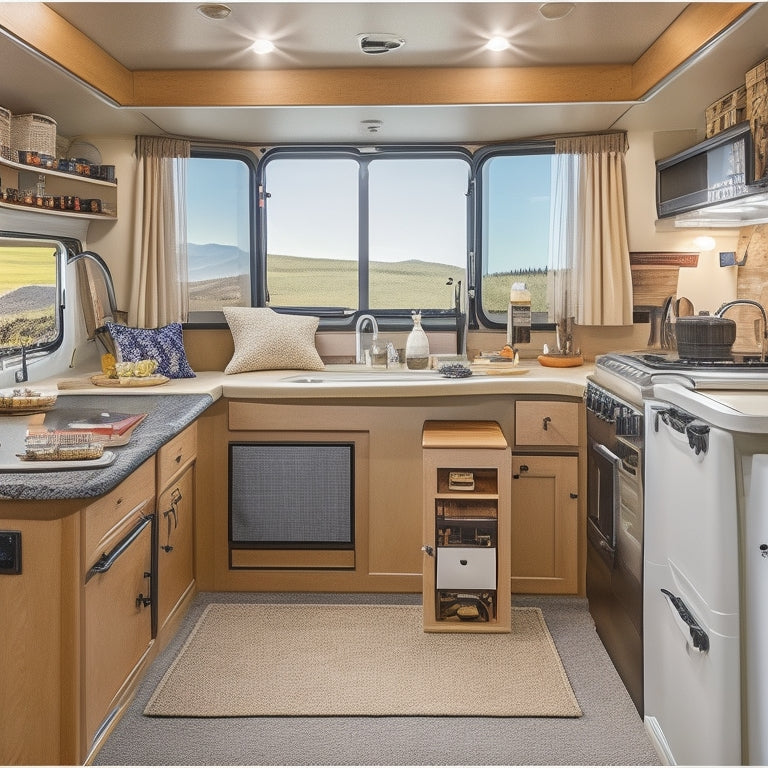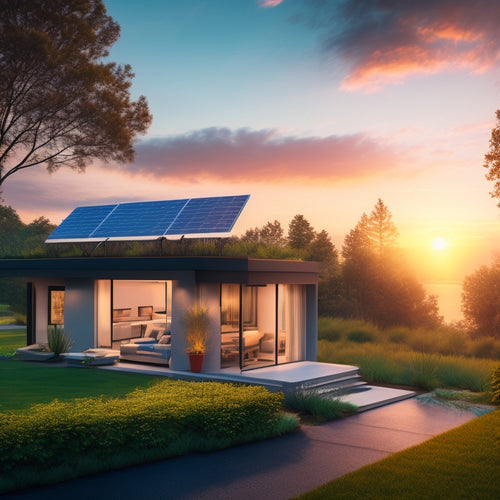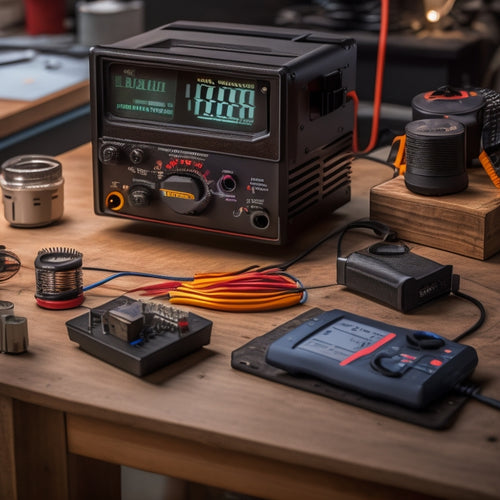
What's in a DIY RV Energy Kit?
Share
You'll need a thorough DIY RV energy kit that addresses six critical components to guarantee a reliable and efficient off-grid energy system. First, you'll calculate your daily energy needs to size the kit appropriately. Next, you'll select solar panels, a charge controller, and an inverter, considering factors like efficiency, cost, and compatibility. Then, you'll choose the right batteries and learn how to care for them. After that, you'll decide on mounting and installation options, and finally, you'll set up monitoring and maintenance essentials to assure peak performance. By covering these bases, you'll be well on your way to a self-sustaining energy system that meets your needs on the go.
Key Takeaways
- A DIY RV Energy Kit includes solar panels, a charge controller, inverter, and batteries to provide off-grid power for your recreational vehicle.
- The kit should be sized according to your daily energy needs, considering devices, usage hours, and watt-hour calculations for accurate planning.
- Essential components include mounting hardware, installation tools, high-quality connectors, and cables for efficient energy transmission and secure setup.
- Monitoring and maintenance are crucial, involving voltage and current meters, state of charge tracking, temperature checks, and routine inspections for peak performance.
- Proper installation, battery care, and compatibility evaluation are vital to ensure a reliable, efficient, and safe DIY RV Energy Kit.
Understanding Your Energy Needs
Before you start building your DIY RV energy kit, it's essential to understand your energy needs.
You'll need to calculate your daily energy consumption to determine the right size of your energy kit. Consider the power efficiency of your appliances and devices, as well as their energy consumption patterns.
Make a list of all the devices you'll be using, including lights, laptops, and refrigerators, and estimate their daily usage hours. Calculate the total watt-hours required to power these devices.
To guarantee you're generating sufficient power, plan for an off-grid lifestyle by considering energy output requirements for effective operation of appliances.
Additionally, evaluate the compatibility of your solar panels with your energy storage solutions. This will help you determine the capacity of your battery bank, solar panel, and charge controller.
Accurate calculations will confirm your energy kit meets your needs, reducing the risk of power outages and equipment failure.
Solar Panel Kit Components
You've calculated your daily energy consumption, and now it's time to focus on the solar panel kit components that will help you generate the power you need.
When selecting solar panels, take into account the type that suits your RV's energy requirements, keeping in mind the significance of assessing specific energy needs to determine the right battery type and size for your power storage. Additionally, prioritize must-have appliances to guarantee a reliable power supply.
You'll need:
-
Monocrystalline or Polycrystalline solar panels: Choose between these two popular solar panel types based on their efficiency, cost, and durability.
-
Mounting hardware: Confirm your panels are securely fastened to your RV's roof using suitable mounting brackets, clamps, and screws.
-
Installation tools: Invest in a set of installation tools, such as a drill, wire strippers, and a multimeter, to make the installation process smoother.
- Connectors and cables: Use high-quality connectors and cables to connect your solar panels to the charge controller and guarantee efficient energy transmission.
Remember to take into account your RV's roof size, weight capacity, and electrical system when choosing your solar panel kit components.
Charge Controller and Inverter
Selecting the right charge controller and inverter is essential for efficiently utilizing the energy generated by your solar panels. A charge controller regulates the flow of energy from your solar panels to your battery, making sure it's charged safely and efficiently.
Accurate sizing of the solar system is significant to guarantee energy independence while traveling Understanding Energy Requirements . In addition, using high-efficiency solar panels with heat resistance can also impact the performance of the charge controller.
There are two primary charge controller types: pulse-width modulation (PWM) and maximum power point tracking (MPPT). MPPT controllers are more efficient, especially in partial shading conditions.
An inverter converts DC power from your battery to AC power for your RV's appliances. Look for an inverter with high efficiency (>90%) to minimize energy loss. Consider a pure sine wave inverter for sensitive electronics.
When choosing a charge controller and inverter, consider factors like compatibility, power rating, and warranty to guarantee a reliable and efficient energy system.
Battery Selection and Care
Configuring your RV's energy system requires careful thought of battery selection and care, as these components play a critical role in storing and providing power when you need it most.
When selecting batteries, you'll want to take into account factors such as capacity, voltage, and type. Lithium batteries, for example, offer high energy density and long lifetimes, making them a popular choice for RV energy systems.
To guarantee peak performance and extend the life of your batteries, you'll need to perform regular maintenance. Here are some key tasks to include in your routine:
-
Monitor State of Charge: Keep track of your battery's state of charge to avoid over-discharging or over-charging.
-
Check Voltage and Temperature: Regularly check voltage and temperature to identify potential issues before they become major problems.
-
Perform Equalization Charges: Periodically perform equalization charges to balance the voltage across your batteries.
- Clean and Inspect Terminals: Clean and inspect terminals to confirm good connections and prevent corrosion.
Mounting and Installation Options
As you prepare to integrate your RV's energy system, securing your batteries and components safely and efficiently is crucial.
You'll need to evaluate mounting techniques that guarantee stability and accessibility. For batteries, use heavy-duty brackets or trays that can be anchored to the RV's frame or floor. Make certain they're securely fastened to prevent shifting during travel.
When installing components like inverters and charge controllers, choose a location with good airflow to prevent overheating. Follow the manufacturer's installation tips and contemplate using a mounting panel or enclosure to keep everything organized.
Properly route cables and wires to avoid damage or electrical shock. By following these guidelines, you'll guarantee a safe and reliable energy system that meets your needs on the road.
Monitoring and Maintenance Essentials
With your RV's energy system components safely installed, you're now ready to focus on the next vital step: keeping tabs on its performance.
Monitoring and maintaining your energy system is essential to guarantee energy efficiency and prevent unexpected failures.
To maintain your system's peak performance, you'll need to perform routine checks on the following:
-
Voltage and current meters: Monitor your system's voltage and current output to detect any anomalies.
-
Battery state of charge: Keep an eye on your battery's state of charge to avoid overcharging or undercharging.
-
System temperature: Check your system's temperature to prevent overheating, which can lead to component failure.
- Energy consumption patterns: Analyze your energy usage patterns to identify areas for improvement and enhance your system's energy efficiency.
Frequently Asked Questions
Can I Mix and Match Components From Different Manufacturers?
You can mix and match components, but guarantee component compatibility by verifying specifications and manufacturer support, as incompatible parts may void warranties or cause system failures, and some manufacturers may not provide support for third-party components.
Are DIY RV Energy Kits Suitable for Full-Time Living?
As you consider full-time RV living, you'll find that DIY energy kits can be suitable, but it depends on your energy efficiency and power management skills - can you optimize your system to meet your daily power needs?
Will a DIY Kit Void My Rv's Warranty?
When you install a DIY RV energy kit, you're likely wondering if it'll void your RV's warranty. Check your warranty terms for specific language regarding aftermarket installations; following manufacturer-approved installation guidelines can minimize warranty implications.
Can I Upgrade My Kit in the Future?
Will you be stuck with yesterday's technology tomorrow? Fortunately not! You can upgrade your DIY RV energy kit in the future, thanks to component compatibility, allowing you to seamlessly integrate new innovations into your existing system.
Are DIY RV Energy Kits Environmentally Friendly?
You'll find that DIY RV energy kits prioritize eco-friendliness, leveraging solar power and energy efficiency to reduce waste and your carbon footprint, while incorporating eco-friendly materials and sustainable battery solutions to minimize environmental impact.
Related Posts
-

The Future of Residential Energy Storage
The future of residential energy storage looks promising and cost-effective for you. With lithium-ion battery prices ...
-

Top Solar Powered Camping Fans for Camping Enthusiasts
If you're a camping enthusiast, a solar-powered fan can be a transformative element for your outdoor experience. Thes...
-

Key Features of a DC to AC Converter
A DC to AC converter features high efficiency and conversion rates, which reduce energy costs and improve performance...


